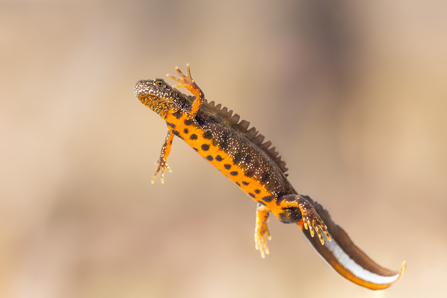Great crested newt populations in the UK are internationally important. However, this species has been in decline in the UK over the past 60 years - despite legal protection and millions of pounds being spent on licences each year.
The District Level Licencing (DLL) scheme hopes to address great crested newt population declines by acting on a landscape scale, rather than a local scale. They hope to achieve this by working with Habitat Delivery Bodies to create and restore more habitats for great crested newts in key areas.
The DLL scheme generates millions of pounds each year and 85% of this goes towards habitat creation, restoration, monitoring and maintenance.
Below is a video from Natural England explaining DLL scheme.
The Lancashire Wildlife Trust act as the Habitat Delivery Body for the Natural England District Level Licencing scheme for modern Lancashire, with the Greater Manchester Ecology Unit (GMEU) being the HDB in Greater Manchester. Unfortunately, the scheme doesn’t currently operate in Merseyside.
The scheme began in Lancashire in 2019 and since then we have created 130 ponds and restored 49 ponds. In 2023-2024 we will also be creating and restoring an additional 30 ponds.
Strategic Opportunity Areas
Strategic Opportunity Areas (SOAs) have been modelled to show suitable habitats for great crested newts and these SOAs are target areas for new ponds to go into.
Here is a video from Natural England explaining the modelling used to find Strategic Opportunity Areas.
How it works
Landowners contact their relevant Habitat Delivery Body (HDB), and a site visit is arranged.
If the site is suitable, some desk checks need to be made - these include checking if the land is within a Strategic Opportunity Area, checking for any designations (such as SSSI status) and a few other things.
If the checks come back clear, your HDB will send over a Landowner Agreement which landowners have to sign - it is a non-legally binding agreement that lasts for 25 years.
The pond is created/restored, and a three month check will be carried out by the HBD so the pond can be documented.
During the 25-year agreement period, water samples are taken in years 2-5 and sent off for testing for the presence of GCN eDNA.
In years 8, 16 and 24, the scheme will pay for bespoke maintenance works.

Great crested newt by The Wildlife Trusts
How to apply
Ponds can be created or restored on public land and privately-owned land. Each landowner can apply for up to six ponds on their land. There is an incentive for landowners requesting two or more ponds.
If you have a patch of land that may be suitable for a DLL pond, or a current pond in need of restoration, then you can contact our Ponds Officer, Rachel Davies, via email on rdavies@lancswt.org.uk.
When making contact, please include a grid reference, postcode or map that shows the area. The first step is always to check if the land falls within a qualifying Strategic Opportunity Area and this information helps the Ponds Officer to complete these checks.
